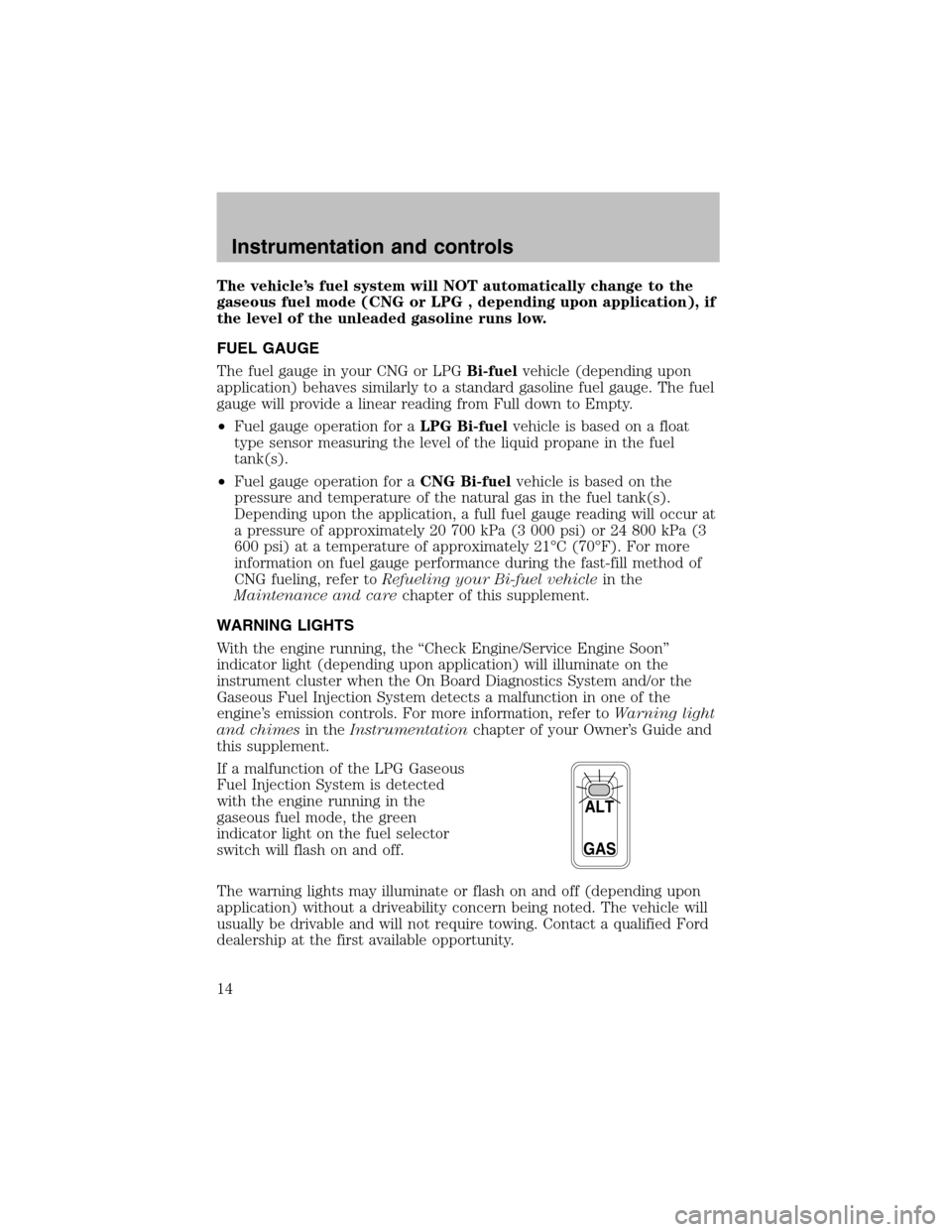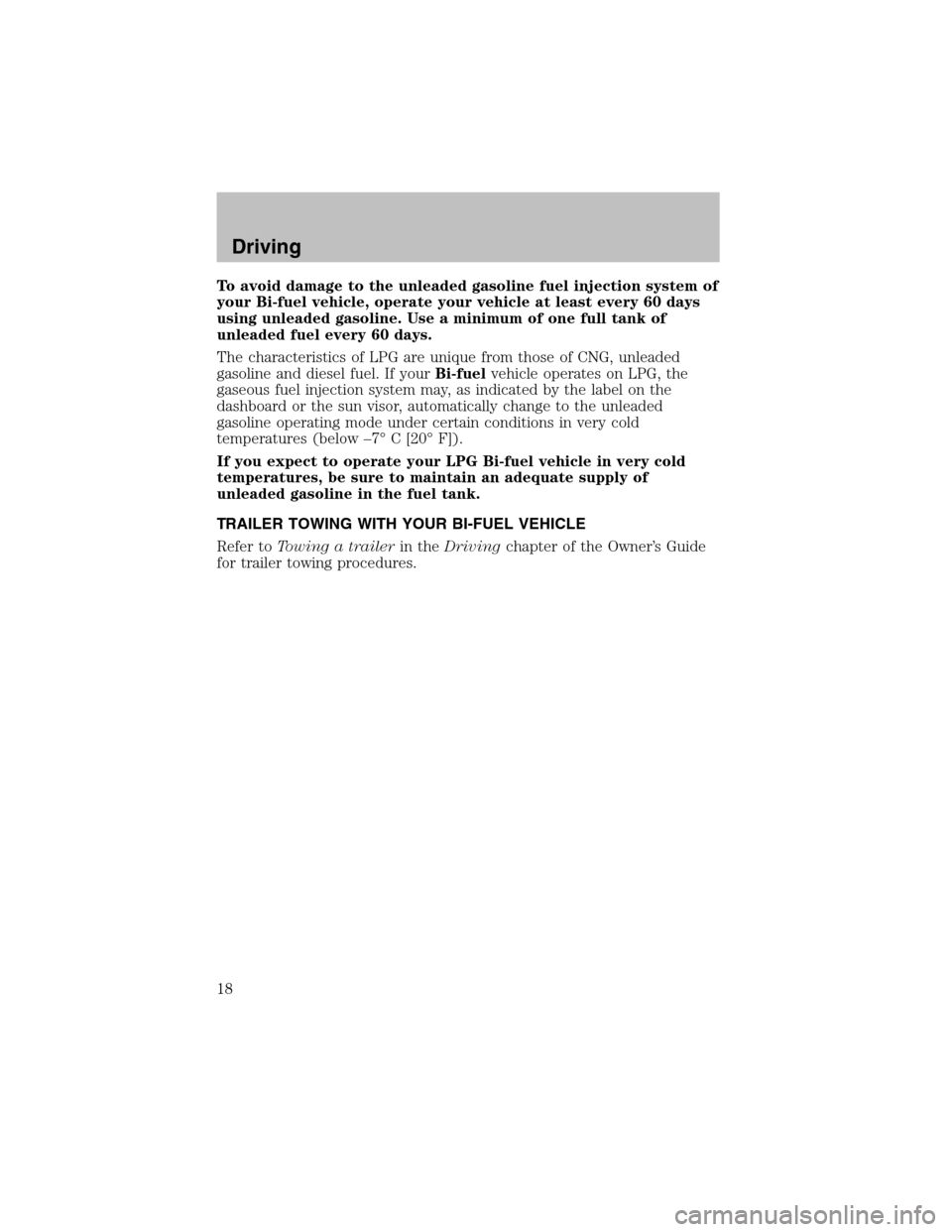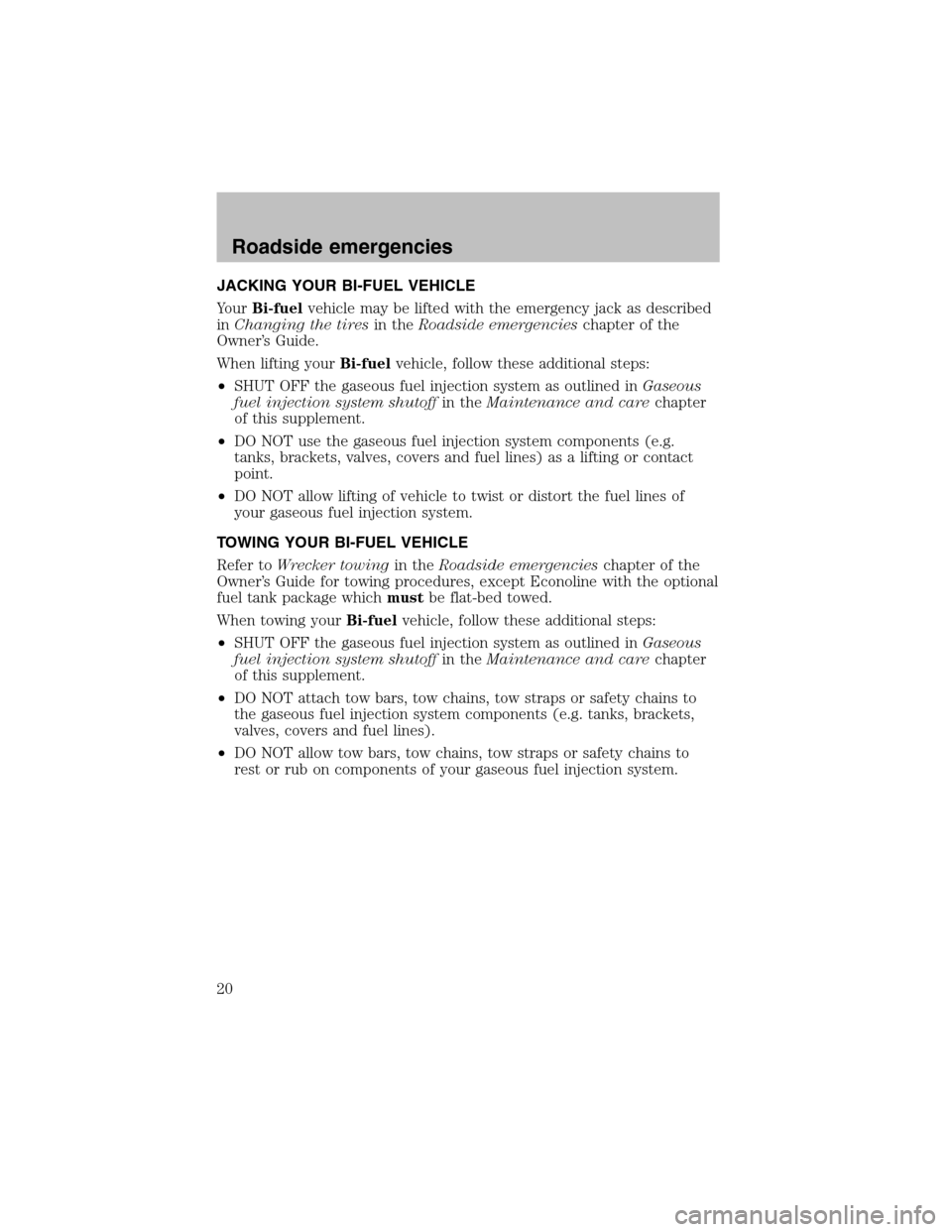towing FORD F150 2003 10.G Bi Fuel Supplement Manual
[x] Cancel search | Manufacturer: FORD, Model Year: 2003, Model line: F150, Model: FORD F150 2003 10.GPages: 72, PDF Size: 4.51 MB
Page 14 of 72

The vehicle’s fuel system will NOT automatically change to the
gaseous fuel mode (CNG or LPG , depending upon application), if
the level of the unleaded gasoline runs low.
FUEL GAUGE
The fuel gauge in your CNG or LPGBi-fuelvehicle (depending upon
application) behaves similarly to a standard gasoline fuel gauge. The fuel
gauge will provide a linear reading from Full down to Empty.
•Fuel gauge operation for aLPG Bi-fuelvehicle is based on a float
type sensor measuring the level of the liquid propane in the fuel
tank(s).
•Fuel gauge operation for aCNG Bi-fuelvehicle is based on the
pressure and temperature of the natural gas in the fuel tank(s).
Depending upon the application, a full fuel gauge reading will occur at
a pressure of approximately 20 700 kPa (3 000 psi) or 24 800 kPa (3
600 psi) at a temperature of approximately 21°C (70°F). For more
information on fuel gauge performance during the fast-fill method of
CNG fueling, refer toRefueling your Bi-fuel vehiclein the
Maintenance and carechapter of this supplement.
WARNING LIGHTS
With the engine running, the“Check Engine/Service Engine Soon”
indicator light (depending upon application) will illuminate on the
instrument cluster when the On Board Diagnostics System and/or the
Gaseous Fuel Injection System detects a malfunction in one of the
engine’s emission controls. For more information, refer toWarning light
and chimesin theInstrumentationchapter of your Owner’s Guide and
this supplement.
If a malfunction of the LPG Gaseous
Fuel Injection System is detected
with the engine running in the
gaseous fuel mode, the green
indicator light on the fuel selector
switch will flash on and off.
The warning lights may illuminate or flash on and off (depending upon
application) without a driveability concern being noted. The vehicle will
usually be drivable and will not require towing. Contact a qualified Ford
dealership at the first available opportunity.
GASALT
Instrumentation and controls
14
Page 18 of 72

To avoid damage to the unleaded gasoline fuel injection system of
your Bi-fuel vehicle, operate your vehicle at least every 60 days
using unleaded gasoline. Use a minimum of one full tank of
unleaded fuel every 60 days.
The characteristics of LPG are unique from those of CNG, unleaded
gasoline and diesel fuel. If yourBi-fuelvehicle operates on LPG, the
gaseous fuel injection system may, as indicated by the label on the
dashboard or the sun visor, automatically change to the unleaded
gasoline operating mode under certain conditions in very cold
temperatures (below–7°C [20°F]).
If you expect to operate your LPG Bi-fuel vehicle in very cold
temperatures, be sure to maintain an adequate supply of
unleaded gasoline in the fuel tank.
TRAILER TOWING WITH YOUR BI-FUEL VEHICLE
Refer toTowing a trailerin theDrivingchapter of the Owner’s Guide
for trailer towing procedures.
Driving
18
Page 20 of 72

JACKING YOUR BI-FUEL VEHICLE
YourBi-fuelvehicle may be lifted with the emergency jack as described
inChanging the tiresin theRoadside emergencieschapter of the
Owner’s Guide.
When lifting yourBi-fuelvehicle, follow these additional steps:
•SHUT OFF the gaseous fuel injection system as outlined inGaseous
fuel injection system shutoffin theMaintenance and carechapter
of this supplement.
•DO NOT use the gaseous fuel injection system components (e.g.
tanks, brackets, valves, covers and fuel lines) as a lifting or contact
point.
•DO NOT allow lifting of vehicle to twist or distort the fuel lines of
your gaseous fuel injection system.
TOWING YOUR BI-FUEL VEHICLE
Refer toWrecker towingin theRoadside emergencieschapter of the
Owner’s Guide for towing procedures, except Econoline with the optional
fuel tank package whichmustbe flat-bed towed.
When towing yourBi-fuelvehicle, follow these additional steps:
•SHUT OFF the gaseous fuel injection system as outlined inGaseous
fuel injection system shutoffin theMaintenance and carechapter
of this supplement.
•DO NOT attach tow bars, tow chains, tow straps or safety chains to
the gaseous fuel injection system components (e.g. tanks, brackets,
valves, covers and fuel lines).
•DO NOT allow tow bars, tow chains, tow straps or safety chains to
rest or rub on components of your gaseous fuel injection system.
Roadside emergencies
20